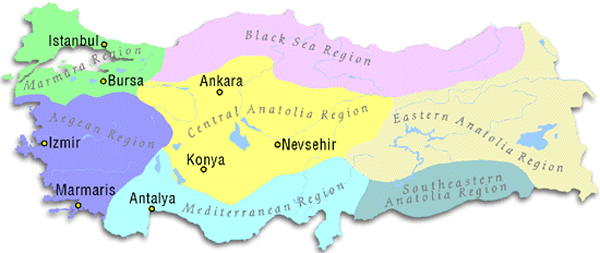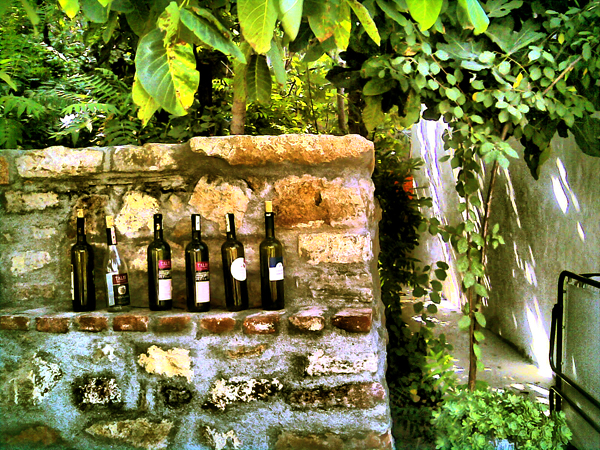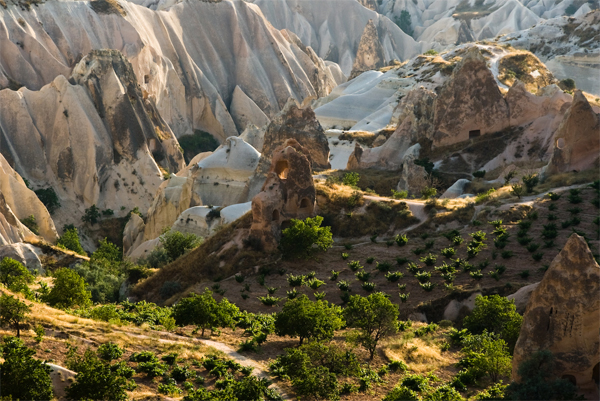Wines of Turkey and Wine Industry
Turkey is one of the oldest lands for cultivating the grapevine for wine. The history of Wines of Turkey production in Anatolia dates back to 4500 years ago, to the Bronze Age. The Hittites were the first people to make laws and regulations about viticulture and wine making. The Euphrates and Tigris Rivers were used to carry wines of Eastern Turkey to the Assyrian and Sumerian lands.
In the tumulus type grave of King Midas of the Phrygians who ruled in the 8C BC, the remains of wine and bread were discover ↗ed.
The biggest temples dedicated to Dionysus, God of wine, were in the Aegean Region of Turkey.
What is the current situation?
Turkey is the fourth largest producer of grapes in the world; however, the majority of these grapes are used to eat and in producing raisins instead of producing wine. Only 2% is used for wine.
Turkey is divided into 5 regions for wine production. The brands that I list below are among the recommended wines and have been chosen from those most readily available in Turkey.
Recommended wines of Turkey
by Murat Yankı, wine specialist

Rating
(A) Average (AA) Above Average (AAA) Much Above Average

Bozcaada Wines of Turkey. Photo by Volkan Çelik
Marmara Region (Around the Marmara Sea)
- Local red grapes: Papazkarası and Adakarası
- International red grapes: Cabernet Sauvignon, Merlot and Gamay
- Local white grapes: Vasilaki and Çavuş
- International white grapes: Semillon
Marmara Region Recommended Wines:
- Red: Sarafin Merlot (AAA), Doluca Antik (AA), DLC Cabernet Sauvignon-Merlot (AA), Kavaklıdere Angora (A)
- White: Sarafin Chardonnay (AAA), Doluca Antik (AA) and Villa Doluca (A)
Aegean Region (Western Anatolia)
- Local red grapes: Cabernet Sauvignon, Carignan and Syrah
- Local white grapes: Misket and Sultaniye
- International white grapes: Chardonnay
Aegean Region Recommended Wines:
- Red: Sevilen Syrah (AA), Sevilen Majestik (A) and DLC Syrah (AA)
- White: Kavaklıdere Angora (A), Doluca DLC Sultaniye-Emir (AA) and Sevilen Chardonnay (AA)
- Rose: Sevilen R. (A) Wines of Turkey
Pamukkale Region (Inner Aegean)
- Local red grapes: Çalkarası
- International red grapes: Cabernet Sauvignon and Merlot
- International white grapes: Chardonnay and Sauvignon Blanc
Pamukkale Region Recommended Wines:
- Red: Anfora Cabernet Sauvignon (AA), Anfora Syrah (AA)
- White: Anfora Senfoni (A), Anfora Chardonnay (A)
- Rose: Kavaklıdere Lal (A)
Central Anatolia (Ankara, Cappadocia and Tokat )
- Local red grapes: Kalecik Karası
- International red grapes: Cabernet Sauvignon and Merlot
- Local white grapes: Emir (from Cappadocia), Narince (from Tokat)
Central Anatolia Recommended Wines:
- Red: Kavaklıdere Ancyra (AA), DLC Kalecik Karası (AA)
- White: Doluca Nevflah (A), Kavaklıdere Çankaya (A), Kavaklıdere Narince (AAA)
Eastern Turkey (Euphrates and Tigris Rivers in North Mesopotamia)
Although there is no white wine production in this region, the red wines are among the best-bodied wines of Turkey.
- Local red grapes: Boğazkere, Öküzgözü
Eastern Wines of Turkey Recommended Wines:
- Red: Terra Öküzgözü-Boğazkere (AA), Kavaklıdere Yakut (A), Doluca Kav (AA)
Wine Industry and How is Wine Made?
The wine industry is a complex and multifaceted sector that involves the cultivation of grapes, the production of wine, and the distribution and sale of wine products. Wine has a rich history dating back thousands of years and is enjoyed by people around the world for its diverse flavors and cultural significance. Here’s an overview of the wine industry and how wine is made:
- Grape Cultivation: Wine production starts with the cultivation of grapevines in vineyards. The choice of grape variety, climate, soil, and vineyard management practices all play a crucial role in the quality and characteristics of the wine.
- Harvesting: Grapes are typically harvested during the late summer or early autumn when they have reached the optimal level of ripeness. The timing of the harvest can significantly impact the flavor and quality of the wine.
- Crushing and Destemming: After harvest, grapes are crushed to release their juice. In some cases, the grapes are also destemmed to remove the stems, as they can contribute bitterness to the wine.
- Fermentation: The grape juice is then transferred to fermentation vessels, typically stainless steel tanks or oak barrels, where yeast is added. Yeast consumes the sugars in the grape juice, converting them into alcohol and carbon dioxide. This process can take anywhere from a few days to several weeks, depending on the type of wine being produced.
- Aging: After fermentation Wines of Turkey, the wine is often aged in barrels or tanks. This aging process can last from a few months to several years, depending on the type of wine and the winemaker’s preferences. Oak barrels can impart flavors and aromas to the wine, while aging can help mellow and develop its complexity.
- Bottling: Once the Wines of Turkey has aged to the desired level, it is filtered and then bottled. Some wines may undergo additional processes like fining or clarification before bottling.
- Distribution and Marketing: The bottled wine is then distributed to markets, restaurants, and retailers. Wineries often market their products through various channels, including wine tastings, wine clubs, and promotional events.
- Types of Wine: There are numerous types of wine produced worldwide, with the main categories being red, white, and rosé. Varietals, blends, and sparkling wines (e.g., Champagne) are also common. The flavor, aroma, and characteristics of wine depend on factors like grape variety, region, climate, and winemaking techniques.
- Wine Regions: Wine is produced in many regions around the world, with some of the most famous wine regions including Bordeaux in France, Napa Valley in the United States, Tuscany in Italy, and Rioja in Spain. Each region has its unique grape varieties and winemaking traditions. Wines of Turkey
- Wine Culture and Consumption: Wine plays a significant role in various cultures and cuisines. It is often enjoyed during meals, celebrations, and social gatherings. Wine appreciation includes aspects such as wine tasting, wine and food pairing, and the study of wine regions and vintages.
The Wines of Turkey industry is dynamic and continually evolving, with new winemaking techniques, sustainability practices, and consumer preferences shaping its development. Wine enthusiasts can explore a wide range of flavors and styles from around the world, making it a fascinating and diverse industry.





